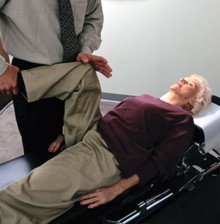Do You Have Sciatica Symptoms

Pain that begins in your lower back and radiates to your buttocks and down through the back of your leg is the characteristic sign of sciatica. |
If you suffer from sciatica symptoms, you may already know that conventional treatments only offer short-term relief. Over-the-counter medications, prescriptions drugs, steroids and surgery all have their own side effects with minimal, temporary benefits. None of these treatments offer a long-term solution to the problem.
Left untreated, sciatica may lead to permanent nerve damage, loss of bowel and bladder function and even loss of feeling and use of the affected leg.
What Causes Sciatica?
You may find it interesting to know that sciatica is not a disorder on its own. It is actually a symptom of a damaged or compressed sciatic nerve. The compression can be caused by various things. For example, it may be due to a slipped disc, herniated or swollen disc, or degenerated discs in your back. Spinal disc conditions can also cause the piriformis muscle in the buttock to irritate the sciatic nerve to create pain in the hip and leg.
Seventeen percent of the population has their sciatic nerve coursing through the piriformis muscle. This subgroup of the population is predisposed to developing sciatica.
Sciatica can be described by pain, tingling, or numbness deep in the buttocks and along the sciatic nerve. Sitting down, stretching, climbing stairs, and performing squats usually increases pain.” Diagnosing the syndrome is usually based on symptoms identified during a physical chiropractic exam.
If you are over 40, you may have an increased risk of developing sciatica. Additionally, your lifestyle may increase your chances of developing the condition. If you are sedentary or have a job where you are frequently seated, or if you have a job that requires you to drive for long hours, twist your back, or carry heavy loads including lifting children or even groceries, these and other similar circumstances such as just bending over may also contribute to developing sciatica.
Diabetics, who have an increased risk of nerve damage, are more likely to develop sciatica. Pregnancy may also irritate the sciatic nerve.
Symptoms of Sciatica: Do You Recognize Any?
Are your symptoms telling you that you have sciatica? The classic symptom of sciatica is pain that radiates from your lower back to your buttocks and down through the back of your leg. Typically, this only occurs in one leg. Pain can range from being very mild to very intense.
Other symptoms may include numbness or weakness in the affected extremity, tingling in your foot or toes or a loss of bowl or bladder control. If this occurs, seek medial help immediately.
Wouldn’t it be great if you could get relief naturally, without drugs or invasive treatments? Thankfully, once you have determined that your pain is indeed sciatica, there are a variety of things you can do at home to help your body to heal so you can get back to your life again.
Resist the Urge to Stay in Bed …
Popular wisdom use to recommend bed rest, but research has found that bed rest really isn’t helpful at all. In most cases, inactive lifestyle is what causes this condition in the first place. In fact, staying active may be the better option. In the first few days after the pain has been triggered, try applying ice packs for 20 minutes at a time throughout the day to reduce inflammation. (Be sure to wrap ice packs in a towel and do not apply directly to your skin.)
- TIP: You can make your own ice pack by mixing three cups of water and one cup of denatured alcohol in a freezer bag. Seal the bag and place in the freezer until the mixture becomes slushy. This freezer pack can be used over and over as needed.
While you should reduce your activity for the first couple of days, you should gradually increase your activity until you are back to your normal activity level. Along with gentle exercise, immediately thereafter apply an ice pack.
Be cautiously aware that although some people may suggest the application of a heat wrap, heating pad or a heated blanket “for comfort” to reduce pain levels, heat treatments can make the condition worse as “heat can cause swelling” – so especially avoid heat for the first 72 hours.
Avoid anything that may strain or twist your back for about six weeks, but don’t feel you must confine yourself to bed and away from your life. Doing so may only make your symptoms worse.
IMPORTANT: Once the pain starts to subside it is not the time to stop activity. It is important to develop and maintain a daily walking or stretching exercise program to build and strengthen damaged muscle and joint tissue. Keeping active will minimize the risk of a return episode.
Medications Offer Only Short-Term Relief
Mainstream treatments for sciatica have limited effectiveness. While doctors often recommend taking over-the-counter NSAIDs, acetaminophen, or even prescription pain relievers, the benefits of these medications should be balanced with the risks, especially considering the results are only short-term and do not treat the cause of the problem. They only mask the actual symptoms and can lead to cardiovascular, gastrointestinal and the risk of harming your kidneys… as well as each having side effects of their own as listed on such products packaging which you should heed their warnings.
Before resorting to drugs, consider some other methods of treating your pain. Several herbal remedies have been shown to be as helpful in treating low back pain which at your next appointment can be assessed as to which will work best based for your personal condition.
Alternative Therapies are Often Effective

Regular scheduled chiropractic care can often help to relieve sciatica symptoms. |
Common therapies for treating sciatica pain include acupuncture, inversion therapy, massage and chiropractic care.
Massage may also be a valuable pain-fighting tool according to a 2011 study that showed nearly 40 percent of patients almost completely eliminated their pain after 10 weeks as compared to only 4 percent of the group that received mainstream treatments.
Chiropractic care has proven successful in the treatment of sciatica. A review of several studies revealed that chiropractic care was as effective as other conventional treatments. Chiropractic is also less invasive and often more cost effective, making it a promising care option for patients.
Your chiropractic physician has various treatment procedures and treatment options.
- Spinal Manipulation improves spinal joint movement. Spinal joint movement prolongs the life of a spinal disc necessary for an active life. Spinal manipulation will reduce pressure from spinal nerves in the low back to decrease pain in the low back, hips, and legs.
- Spinal Decompression: Pulls and separates spinal discs damaged by injury or degeneration from aging. This treatment is similar to traction but very specific to lumbar spinal discs and nerves.
- Flexion Distraction: Separates and tractions the lumbar spine to take pressure off the discs and spinal nerves. This treatment is also used to increase spinal joint movement necessary for improving and maintaining lumbar disc health.
- Physical therapy: Ultrasound, muscle stimulation, and laser treatments to strengthen weak and damaged soft tissues. An exercise program is an important factor in improving your condition for the long term.
Research the Best Options for You
There is a wide variety of options available to naturally treat your sciatica pain while avoiding invasive treatments and dangerous medications. Discuss these options with your health care provider so that together you can create an effective treatment plan to aid in your recovery. Weigh the benefits and potential side effects of all treatment possibilities so you can make an informed decision and get on track to healing so you can get on with the pain-free life you deserve.
Sources
Disabil Rehabil.;34(17):1473-80. Epub
Wikipedia.org “Piriformis Syndrome”
Zhongguo Zhen Jiu.;31(5):425-8.
Cochrane Database Syst Rev.;(4):CD001254.
Cochrane Database Syst Rev.;(2):CD003632.
Cochrane Database Syst Rev.;(1):CD004750.
Arch Intern Med.;160(14):2093-9.
Cochrane Database Syst Rev.;(2):CD004504.
Spine (Phila Pa 1976). 15;34(16):1669-84.
Cochrane Database Syst Rev.6;(2):CD008112.
J Manipulative Physical Ther.(3):197-210
Journal of Manipulative and Physiological Therapeutics.;27(6):388–398.
Journal of Manipulative and Physiological Therapeutics;26(9):593–601





